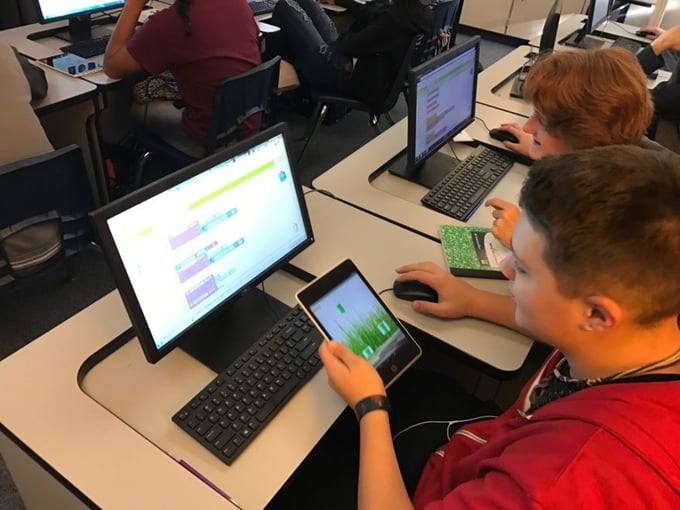Stephen Swanson teaches at Sand Creek High School in Colorado Springs, Colorado. Stephen has been teaching computers for eight years and just began teaching PLTW's Computer Science Principles (CSP) for the first time this year. Stephen enjoys enlightening students to the possibilities of computing.
Students at Sand Creek have been given the opportunity to get their feet wet with computer science for the first time this year. Students who have no prior experience have flourished with the high-interest teaching materials PLTW provides. I have students ranging from freshmen to seniors all working together to create awesome algorithms, apps, and fully functional programs. Through our adopted moniker of ScorpSoft, we act as a real-world working environment in which students are not only accountable to me as a teacher, but are also accountable to each other in teams of developers.
As a whole team at ScorpSoft, students are working in interchangeable teams with the aim of creating the best-possible product given the design brief. Since they know they’re all working toward the same goal, they are always more than willing to lend each other a hand and build skills that individuals may need assistance on. Even though I’m more than willing to help them myself, it’s always more authentic when a student understands a concept enough to be able to explain it to a peer!
This environment of collaboration helps students practice the skills they’ve learned from the content by supervising each other’s progress and knowledge. It leads to independent learning. Students who came in with no prior experience are building strong skills and more interest in CS as a possible future field of study as we continue to expand the CS offerings here. Many more students are coming from our feeder middle school having experienced computer science through PLTW as 8th graders, so in the coming years, more and more students will be coming into our CS pipeline.
The PLTW CSP course at our school has helped students learn new ways of interacting with each other and has already opened many possibilities for students to take their work outside of the classroom. For instance, one student had a project to complete for a social studies class and decided to make an app using MIT’s App Inventor 2 in order to share information in a more interactive format than a standard presentation or a paper. Other students have gone home and made apps on Scratch for fun to draw or tell other kinds of stories. Other students have taken it upon themselves to become multilingual in programming. Even though our main focus is Python, I have students who want to learn Ruby on Rails and some students who want to learn more about web-based languages. In addition, students are always applying the languages taught directly in class to new and different things. Their willingness to take learning from my class and apply it elsewhere is empowering and wonderful.
When students see how what they're learning is how the rest of the world really uses information, they understand that the class is genuine and practical. Students who are reluctant in many classes put forth more effort than they would elsewhere simply because they know how it applies right then and there. They see the results of their knowledge almost instantly. It’s truly powerful to be able to have students choose a program, stick out the tough learning, and use it in their non-academic lives almost immediately.
PLTW’s blog is intended to serve as a forum for ideas and perspectives from across our network. The opinions expressed are those of each guest author.

